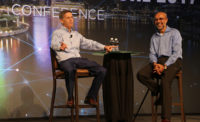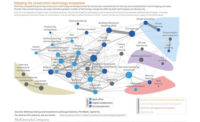Mankowski says Vortex gets its cloud processing alacrity from client-side software algorithms that analyze calls to the model for data and refine resolution delivery on the fly, based on the view requested and the device's display capacity. Pointools never delivers more points of data than a screen has the pixels to display at any given level of zoom. "We just get back that subset of points that are needed to fulfill the request. There is a limited number of pixels on the screen—no need to bring back 20 points for one dot," he says.
In announcing the acquisition, CEO Greg Bentley noted that scanning devices are becoming commonplace and scanning now is cost-effective; but point clouds have served only for temporary and task-specific purposes because the scale of the data files has been so overwhelming. Now, however, Bentley predicts point clouds will take their place in the work flow "as a fundamental data type [that] can usefully serve the function of an 'as-operated' 3D model for every infrastructure asset," according to Bentley.
Singh says the Pointools acquisition will help unlock the value of point-cloud data and surmount the "big data" problem of point-cloud users. Another new service in ProjectWise, expected to be available by the end of the year, will manage point clouds and stream, on-demand, the subset of the cloud data desired. He says the stream will come as a separate thread that will not impede other software performance. Adds Bentley, "It makes it practical to incorporate existing-condition point clouds in your data."
"The point-cloud market is on fire in terms of growth," commented Joe Croser, who was Pointools vice president of products, sales, marketing and product strategy prior to the acquisition. Now, he says, he does not yet know what his title will be when the company is integrated into the Bentley family, but he has already been there once, having left a position of global marketing director at Bentley 14 months ago to join Pointools.
"Pointools is clever in how it streams, caches and assumes what you are going to want to do next." Croser says. It is not artificial intelligence, he adds, but the software starts caching peripheral information outside the area you ask to view. When you make a request to look elsewhere, it can display the data very quickly.
He says Pointools' strong suits are that it can work quickly with huge point clouds of very many hardware vendors' proprietary formats; translate them into its own POD format, which can be used to work with point clouds in many other applications; and run on an ordinary computer.
"I think you can bank on the idea that now that [Bentley has] the source code, [it] can put this capability in any application [the company] develops," Croser says.
Bundling Design and Simulation
In new products, Bentley announced the replacement and re-organization of the company's building-design software products for architecture, engineering, and mechanical, electrical and plumbing—which are all based on the MicroStation platform—into a single product, AECOsim Building Designer, which can be used in a concurrent, integrated fashion with AECOsim Energy Simulator, an energy-use simulation tool. The aim is to serve the increasingly analytical and simulation-driven process of design development.
Users can select from discipline-specific interfaces appropriate to the various tasks, but shifting between them does not require exporting and importing the model to coordinate, Roberts says. AECOsim Energy Simulator is available now. The Building Designer is in Bentley's early-adopter program, with commercial availability promised for the first quarter of 2012.









Post a comment to this article
Report Abusive Comment